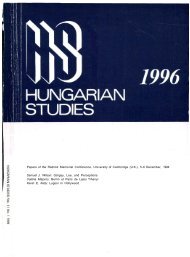The Canadian-American Review of Hungarian Studies - Vol. 4 ... - EPA
The Canadian-American Review of Hungarian Studies - Vol. 4 ... - EPA
The Canadian-American Review of Hungarian Studies - Vol. 4 ... - EPA
Create successful ePaper yourself
Turn your PDF publications into a flip-book with our unique Google optimized e-Paper software.
Magyar poets and writers to the reading public <strong>of</strong> Canada and otherEnglish-speaking countries. This has substantially helped to enhancethe Magyars' reputation in this country and elsewhere.<strong>The</strong> improvement <strong>of</strong> the reputation <strong>of</strong> <strong>Hungarian</strong>s was particularlyimportant in Canada where, until recent times, the general publicregarded immigrants from central and eastern Europe with a great deal<strong>of</strong> reserve and even disdain. Given the natural proclivity <strong>of</strong> the nativebornin any country to receive newcomers with suspicion, the <strong>Canadian</strong>public's lack <strong>of</strong> confidence in and respect for immigrant groups isunderstandable. <strong>The</strong>se attitudes were just another difficulty newcomershad to endure. For the sake <strong>of</strong> a healthier atmosphere in Canada'spolitical, civic and social life, these attitudes had to be eliminated sooneror later.<strong>The</strong> overcoming <strong>of</strong> nativistic antagonisms towards immigrants was adifficult process. Each newcomer individually and each ethnic groupcollectively had to prove to the native-born that, far from constitutingathreat, immigrants were an asset to Canada's economic, political andcultural life. In this struggle for acceptance some newcomers werehelped by the fact that they could learn English or French faster becausetheir own mother tongues were similar. Other groups may have had areputation established in agriculture, or craftsmanship, or business, orarts and culture, even before their members began migrating to Canadain large numbers. <strong>Hungarian</strong>s were not so fortunate. Magyar is a Ural-Altaic language, hence <strong>Hungarian</strong> newcomers tended to learn Englishor French more slowly than immigrants speaking Germanic or Romancelanguages. <strong>Canadian</strong>s knew nothing or next to nothing aboutHungary's culture, and could learn little about it from poorly educatedpeasants who rarely learned more than a few words <strong>of</strong> English. Educated<strong>Hungarian</strong>s were, on the whole, not admitted to Canada untilafter 1945, and those who managed to land here despite regulations hadlittle time to preach the excellence <strong>of</strong> their people's cultural heritage.Until the post-World War II period, moreover, Canada's <strong>Hungarian</strong>slived in isolation, or at best, in scattered, small communities, whichwere unable to generate a cultural life which would gain the appreciation<strong>of</strong> the public at large. Unable to prove their value and their culturalequality to the native-born population, <strong>Canadian</strong>s <strong>of</strong> <strong>Hungarian</strong> backgroundsurvived the first half <strong>of</strong> the twentieth century as victims <strong>of</strong>nativistic prejudice, and subsisted as second-class citizens in a land <strong>of</strong>freedom and plenty. For most <strong>of</strong> them it was a difficult and degradingexperience. As a result <strong>of</strong> a combination <strong>of</strong> factors, gradually their lotimproved. No doubt, one <strong>of</strong> these factors was the work <strong>of</strong> WatsonKirkconnell.
















